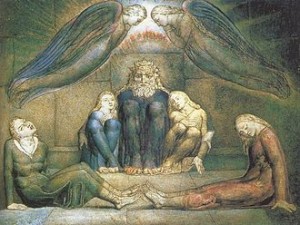[Ugolino and his sons in their cell, William Blake, circa 1826]
The following paper, by Sára Tóth, was presented at the international Frye conference in Budapest (“Northrop Frye: 100 — A Danubian Perspective,” September 7-8, 2012, Budapest).
The Paradisal Pole: a Frygean Perspective on European Irony:
The Example of the Danish Film Green Butchers
Sára Tóth
In this paper I will attempt to apply what I believe is Northrop Frye’s perspective on one significant feature of European élite culture. I do not use the term European in a geographical but in a sociological sense, having in mind the culture of the secularised élite all over the world, which, according to Peter Berger, constitutes, as it were, a European island even in America (Berger 11). This feature happens to be an attitude of extreme irony, more precisely, the tendency of interpreters to overlook textual data which may counterpoint or call into question the predominance of the ironical vision of alienation. The concept of irony is thus brought into play not simply in the traditional sense of a rhetorical trope, but in a philosophical or existential sense, first theorised by Romantic philosophers, and afterwards by thinkers such as Kierkegaard, Paul de Man or Frye himself.
1
It is well known for readers of Anatomy of Criticism that irony, coupled with satire, is a very important point of orientation in Frye’s literary universe. In his circle of the four pregeneric plots or mythoi (comedy, romance, tragedy, irony/satire), or in his U shaped quest irony is the lowest point. Whereas tragedy, associated with autumn, implies the downward movement of a hero of great power of action, irony implies the lack of action. Characters are not traveling downward because they are already down, totally paralysed as it were. This scheme corresponds to Frye’s historical modes which proceed from myth through romance, through the high and low mimetic to the ironic mode. Whereas in the mythic mode the “hero” is superior to us, normal beings in degree and kind, at its opposite, in the ironic mode he or she is worse than us and has the least power of action. Whereas in Frye’s polarized world of imagery the apocalyptic group of images belongs to the mythic mode and presents a world of fulfilled desire, its opposite, demonic imagery belongs to the ironic mode, a repudiated world of unfulfilled desire, of unrelieved suffering and alienation.
In short, Frye in the Anatomy of Criticism suggests that irony has a demonic quality to it, and later in Words with Power he calls the pole of irony quite consistently “hell world” and its opposite – referred to in Anatomy as the mythic and apocalyptic – the paradisal pole. Quite logically, Frye’s world of irony and satire, being the mythos of winter, is a cold hell, a frozen and motionless sphere. (Not quite accidentally, the film I am about to discuss to has some important scenes in the meat freezer of a butcher shop.) The positive energy in Frye’s universe is human desire, which transforms nature into a home, helping us achieve oneness with other people, with the exterior world and with God, and thus finding true identity. At the other pole action and motion are absent, no transformation takes place, which leaves us in the hell world of alienation: from nature, from other people, from God, and from ourselves. As opposed to identification with who and whatever is other, in the hellish state of irony we experience extreme detachment and objectivity to the point of being overpowered by the objective world we cannot change, even being turned into objects ourselves.[1]
This account is very similar to Paul de Man’s ironic vision of language and of the human condition, with the substantial difference that for de Man irony is not one pole but it is the only authentic interpretation of existence. For de Man words do not have the power to unite subject and object, self and world, language being a network of signs referring endlessly to other signs and never achieving oneness with something other and real. Neither can the self achieve oneness with the non-self or with itself for that matter. In an endless series of acts of consciousness attempting to grasp its own reality, the self is doubled, multiplied and is finally dissolved in the “narrowing spiral of a linguistic sign … more and more remote from its meaning” (De Man 222). De Man picks up Baudelaire’s example of a stumbling and falling man laughing at himself falling, and invests this scene with a philosophical significance, turning it into a symbolical Fall, in the course of which the divided or split self comes to view himself as object, treated by Nature “as if he were a thing … whereas he is quite powerless to turn the smallest particle of nature into something human.” (214)
Decisive thinkers of the last century such as Paul de Man tend to absolutize or essentialize the hell world of irony and satire, the state of alienation and split. To mention another towering figure, Jacques Lacan’s vision of the self and its relation to the world, is dominated, as Frye would say, by the archetype of satire which is sparagmos: fragmentation or tearing to pieces. The self or ego as seen by Lacan is always already fragmented, in bits and pieces, the integrated imago being the deceptive result of an imposition of a rigid and artificial unity on this chaotic turbulence (see Lacan 97). According to one of his critics, Joel Whitebook, in Lacan’s work synthesis and integration are suspected as inauthentic, and contrary evidence tends to be overlooked. Lacan, Whitebook argues, tendentiously misrepresents Freud by placing almost sole emphasis on the death drive as opposed to the integrating Eros (see Whitebook 122–128).
